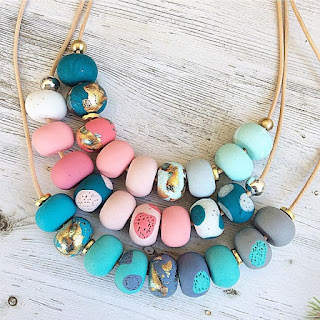Polymer clay jewellery is the latest most trending fashion among the jewellery fashion. From classic to modern designs all can be done by polymer clay. Let us know more about Polymer clay jewellery, making, advantages etc...,
Polymer clay which is also called the oven baked lay or the sculpey. Polymer clay is made from the synthetic material including PVC powder, plasticizers, binders, fillers, lubricants and pigments. Polymer clay is a wonderful alternative to regular clay for home sculpting projects. Raw, it has a consistency of plasticine and can be bought in varying degrees of hardness; this can later be softened by manually working it, running it through a pasta machine or adding a very small amount of alcohol/white spirit. The great thing about polymer clay is that, while it's soft and easy to manipulate, when baked it becomes hard. Because it's so versatile, it can be used to make many different kinds of jewelry.
Let us see some of the advantages of Polymer clay jewellery:
• It's relatively inexpensive and can easily be manipulated to form figurines, beads for jewellery, vase, flowers, etc..,
• They won't dry out until they are baked hard.
• Polymer clay is non-toxic, however the makers do follow certain guidelines in making jewellery to avoid any problems.
• It is easily available in most chain craft stores.
• Polymer clay when stored properly and kept out of direct sunlight and excessive heat, stays for years.
• No need to paint it, in Polymer clay jewellery we use the mixed color clay so that we can have any color of your choice on jewellery without coloring with paint. Thus it gets that premium look and feel.
Let us see some of the disadvantages of Polymer clay jewellery:
• There are also fewer potential health hazards when working with polymer clays, as unlike ceramics they don’t dry and leave a powdery build-up which could cause serious long term health issues if accidentally inhaled or ingested.
• Polymer clay is considered to be non-toxic (still, don’t eat it), although it isn’t suitable to eat from, so any cups or plates you might want to make are probably best left to ceramics ,making sure you use the correct finishing glaze.
• At some points Polymer clay is expensive compared to others products used to make jewellery.
Polymer Clay Jewelry Techniques :
• Conditioning : Polymer clay must be conditioned to soften the clay and make it easier to work with. To condition clay, knead it with your hands to warm it and then flatten it until it’s thin enough to pass through a clay-dedicated pasta machine. Folding and passing polymer clay through a pasta machine repeatedly, raising the setting each time, conditions clay beautifully and prepares it for making polymer clay jewelry.
• Color-Making : One of polymer clay’s most appealing features is color. It comes in so many colors and can be blended into a limitless variety of more colors. Mix polymer clay colors the same way you condition the clay. Skinner blends are popular polymer clay creations that blend from one color into another one or with white to resemble ombre designs.
• Forming and Shaping : This is the fun part. You can carve clay, ruffle it, weave it, mold it, layer it, texture it, stamp it, coil it … anything goes, really! Ceramic tiles and wax paper are ideal surfaces on which to work with polymer clay. One of the most creative polymer-clay techniques is caning.
• Curing : To harden and preserve your polymer clay jewelry creations, cure clay in a clay-dedicated small toaster oven. Bake the clay on parchment paper on cardboard or on a ceramic tile. Note that curing clay directly on metal will create shiny spots on it.
• Finishing : After your polymer clay jewelry masterpieces are cured and cooled, they need to be finished like any other jewelry creation. Finishing polymer clay means wet sanding with waterproof sandpaper or a sanding sponge, using progressively finer grits, and then dry polishing with a rotary tool or something similar and a cloth buffing wheel. Follow that by coating with a thin layer of varnish or clear sealant if you want to further protect it and/or add shine to highlight certain areas.
These are few basic steps followed to make jewellery with Polymer clay. These are pretty easy to follow and quickly done. Try out making Polymer clay jewellery if you are intrested in making diy jewelry.
Here are a few designs for the latest trendy Polymer clay jewellery. Check out!!
Polymer clay jewellery!!
 Reviewed by Jewellery Designs
on
April 26, 2020
Rating:
Reviewed by Jewellery Designs
on
April 26, 2020
Rating:
 Reviewed by Jewellery Designs
on
April 26, 2020
Rating:
Reviewed by Jewellery Designs
on
April 26, 2020
Rating:



















No comments: